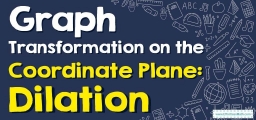How to Find a Coordinate: Dilation
Dilations are a fundamental aspect of coordinate geometry, with widespread applications in fields such as physics, computer graphics, and architectural design. Understanding the process of dilation is essential to accurately manipulating and interpreting coordinates.

Coordinate dilation is a transformation that alters the size of a figure without changing its shape or orientation. The process scales up or down the distances between all points of a shape from a fixed point, known as the center of dilation.
A Step-by-step Guide to Finding a Coordinate: Dilation
Step 1: Identify the Center of Dilation
The first step in performing a coordinate dilation is to identify the center of dilation. This point acts as a fulcrum from which all other points within the shape will be dilated. In a coordinate plane, this can be any point, but it is typically chosen for convenience.
Step 2: Determine the Scale Factor
The next step involves determining the scale factor, denoted by the symbol ‘\(k\)’. The scale factor indicates how much the figure will be enlarged or reduced. If ‘\(k\)’ is greater than \(1\), the figure will be enlarged; if it’s between \(0\) and \(1\), the figure will be reduced; if ‘\(k\)’ is negative, the figure will be enlarged and reflected.
Step 3: Perform the Dilation
With the center of dilation and scale factor identified, you can now proceed with the dilation. This involves multiplying the coordinates of each point in the shape by the scale factor. It’s important to remember that the coordinates are measured from the center of dilation.
Step 4: Plot the Dilated Figure
After performing the dilation, the final step is to plot the new points on the coordinate plane. Connect the points to complete the dilated figure. Note that the shape and orientation remain unchanged, but the size of the figure has been altered according to the scale factor.
An Example of Coordinate Dilation
Consider a square with vertices at points \((2,2), (4,2), (4,4)\), and \((2,4)\). We choose the origin \((0,0)\) as our center of dilation and a scale factor of \(2\). We multiply the coordinates of each point by the scale factor to get our new points: \((4,4), (8,4), (8,8)\), and \((4,8)\). Plotting these on the coordinate plane, we see our original square has been dilated to twice its original size.

Conclusion
Coordinate dilation is a straightforward yet powerful concept in geometry, enabling us to change the size of shapes while maintaining their form and orientation. Through careful identification of the center of dilation, thoughtful selection of a scale factor, and diligent application of these elements, we can successfully dilate coordinates on a plane. It is a skill that not only benefits students in solving geometry problems but also professionals in fields such as computer graphics and architectural design, where the understanding of space, scale, and proportion is vital.
Related to This Article
More math articles
- 8th Grade SBAC Math FREE Sample Practice Questions
- SHSAT Math – Test Day Tips
- The Ultimate Praxis Core Math Formula Cheat Sheet
- How to Solve Arithmetic Series
- HSPT Math-Test Day Tips
- The Best School Supplies for Learning Math
- How to Solve Multi-step Word Problems of Money
- How to Evaluate Decimal Distances on the Map
- Top 10 6th Grade NYSE Math Practice Questions
- 4th Grade OSTP Math Worksheets: FREE & Printable


















What people say about "How to Find a Coordinate: Dilation - Effortless Math: We Help Students Learn to LOVE Mathematics"?
No one replied yet.